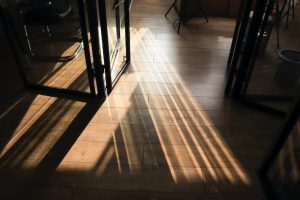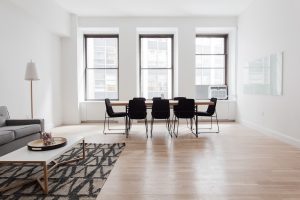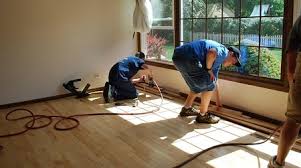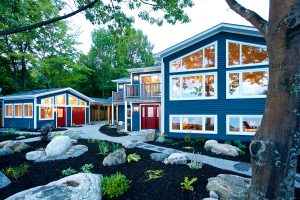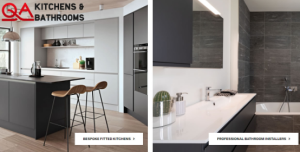The Appeal of Oak Flooring
Oak flooring has long been a favourite in UK homes due to its durability, warmth, and timeless style. Whether in solid or engineered form, oak adds character and a sense of quality to any space. Its natural grain and rich tones make it versatile enough to complement both traditional and contemporary interiors. Many homeowners consider oak flooring when renovating kitchens and bathrooms, as it can create a seamless flow throughout the home. However, kitchens and bathrooms present unique challenges for any type of wood flooring due to higher levels of moisture and humidity.
Understanding the Challenges of Moisture
Both kitchens and bathrooms are prone to spills, splashes, and humidity. While oak is a strong and resilient hardwood, it is still a natural material that can expand, contract, or warp when exposed to excess moisture. Bathrooms, in particular, have more consistent humidity from showers and baths, which can be problematic for traditional solid wood flooring. Kitchens present slightly less risk, but spills and cleaning routines still require a practical approach to maintenance.
Because of these conditions, choosing the right type of oak flooring is essential. Engineered oak flooring, for example, is constructed with a top layer of real oak and multiple layers of plywood beneath. This structure makes it more stable than solid oak, reducing the likelihood of movement when exposed to changes in moisture and temperature.
Engineered Oak Flooring in Kitchens
Engineered oak flooring is generally considered a good option for kitchens. Its layered construction gives it greater stability, meaning it can better withstand occasional spills and temperature fluctuations compared to solid oak. When finished with a protective seal, engineered oak flooring is also relatively easy to clean, making it a practical choice for busy family kitchens.
For kitchens with open-plan layouts, engineered oak flooring can create a seamless look that flows into dining or living spaces. Its versatility allows it to complement a wide range of cabinet colours and styles, from rustic farmhouse designs to sleek modern kitchens.
Oak Flooring in Bathrooms
Using oak flooring in bathrooms is more complex. While engineered oak offers better resistance to moisture than solid oak, bathrooms are high-humidity environments where water can remain on the floor for longer periods. Any wood flooring used in bathrooms must be carefully sealed and maintained to prevent water damage.
Homeowners who want the look of oak in their bathroom should choose high-quality engineered boards with a durable, water-resistant finish. It is also important to wipe up any spills immediately and ensure the bathroom is well ventilated. Even with these precautions, oak flooring in bathrooms requires more care compared to tiles or vinyl alternatives.
Finishing and Sealing for Protection
Regardless of whether oak flooring is used in a kitchen or bathroom, the finish plays a vital role in its durability. Oils, lacquers, and hardwax finishes all provide a layer of protection against moisture, but regular maintenance is essential to keep this protection effective. Reapplying finishes as recommended by the manufacturer will help prevent water from seeping into the wood and causing damage.
Choosing a matt or satin finish can also be practical, as these options show fewer marks or scratches over time. Many homeowners prefer finishes that enhance the natural grain of the oak, giving a warm and authentic appearance while still offering necessary protection.
The Importance of Proper Installation
Professional installation is crucial when fitting oak flooring in kitchens and bathrooms. Expansion gaps must be left around the edges to allow for natural movement of the wood. Sealants should be applied to joints and edges to provide extra protection against water ingress. Using high-quality underlay and moisture barriers can also improve the longevity of the flooring.
Floating installations, where boards are not glued or nailed directly to the subfloor, can be beneficial for engineered oak as they allow for slight movement without causing damage. In bathrooms especially, attention to detail during installation can make a significant difference to the floor’s long-term performance.
Maintaining Oak Flooring in Wet Areas
Caring for oak flooring in kitchens and bathrooms involves a few additional steps compared to other rooms. Spills should be wiped up promptly, and the floor should be cleaned with a damp mop rather than soaked. Harsh chemicals and steam mops should be avoided, as they can damage the finish and allow moisture to penetrate the wood.
Rugs and mats placed near sinks, cookers, and baths can help protect the floor from water splashes. Regularly checking the finish and reapplying protective coats when needed will ensure that the flooring continues to perform well in these demanding environments.
Alternative Options for a Wood-Look Finish
For homeowners concerned about the practicality of oak flooring in bathrooms, there are alternatives that replicate the appearance of wood without the same maintenance requirements. LVT (luxury vinyl tile) and wood-effect tiles can achieve a similar aesthetic while being completely water-resistant. These options can be ideal for bathrooms or very busy kitchens while still complementing real oak flooring in other parts of the home.
Making the Right Choice for Your Home
Oak flooring can be suitable for kitchens and, with care, even for bathrooms if the right product is chosen and correctly maintained. Engineered oak flooring offers the best balance of beauty and practicality, making it a popular choice for households that want a natural wood finish in moisture-prone rooms. By selecting a high-quality product, ensuring professional installation, and committing to regular maintenance, homeowners can enjoy the timeless appeal of oak flooring without compromising on durability or style.
